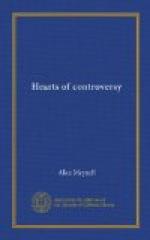Emily Bronte was no student of books. It was not from among the fruits of any other author’s labour that she gathered these eminent words. But I think I have found the suggestion of this action of Heathcliff’s—the disinterment. Not in any inspiring ancient Irish legend, as has been suggested, did Emily Bronte find her incident; she found it (but she made, and did not find, its beauty) in a mere costume romance of Bulwer Lytton, whom Charlotte Bronte, as we know, did not admire. And Emily showed no sign at all of admiration when she did him so much honour as to borrow the action of his studio-bravo.
Heathcliff’s love for Catherine’s past childhood is one of the profound surprises of this unparalleled book; it is to call her childish ghost—the ghost of the little girl—when she has been a dead adult woman twenty years that the inhuman lover opens the window of the house on the Heights. Something is this that the reader knew not how to look for. Another thing known to genius and beyond a reader’s hope is the tempestuous purity of those passions. This wild quality of purity has a counterpart in the brief passages of nature that make the summers, the waters, the woods, and the windy heights of that murderous story seem so sweet. The “beck” that was audible beyond the hills after rain, the “heath on the top of Wuthering Heights” whereon, in her dream of Heaven, Catherine, flung out by angry angels, awoke sobbing for joy; the bird whose feathers she—delirious creature—plucks from the pillow of her deathbed ("This—I should know it among a thousand—it’s a lapwing’s. Bonny bird; wheeling over our heads in the middle of the moor. It wanted to get to its nest, for the clouds had touched the swells and it felt rain coming"); the only two white spots of snow left on all the moors, and the brooks brim-full; the old apple-trees, the smell of stocks and wallflowers in the brief summer, the few fir-trees by Catherine’s window-bars, the early moon—I know not where are landscapes more exquisite and natural. And among the signs of death where is any fresher than the window seen from the garden to be swinging open in the morning, when Heathcliff lay within, dead and drenched with rain?
None of these things are presented by images. Nor is that signal passage wherewith the book comes to a close. Be it permitted to cite it here again. It has taken its place, it is among the paragons of our literature. Our language will not lapse or derogate while this prose stands for appeal: “I lingered . . . under that benign sky; watched the moths fluttering among the heath and harebells, listened to the soft wind breathing through the grass, and wondered how anyone could ever imagine unquiet slumbers for the sleepers in that quiet earth.”




